The future of online learning: what have we learned from COVID-19 emergency remote education initiatives?
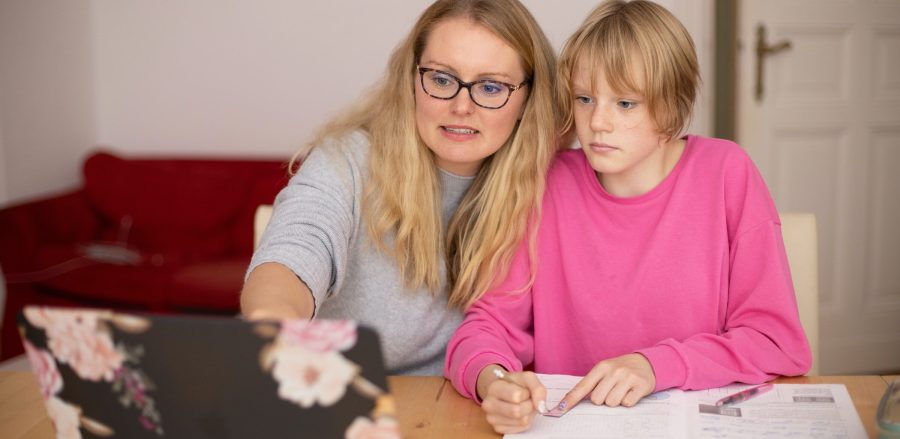
This is a summary of findings and recommendations from IPPO’s new systematic review of evidence across 38 countries. To read the full report, click here
- Read this related blog: The classroom of the future: how has COVID-19 changed the ways children learn and teachers teach?
Introduction
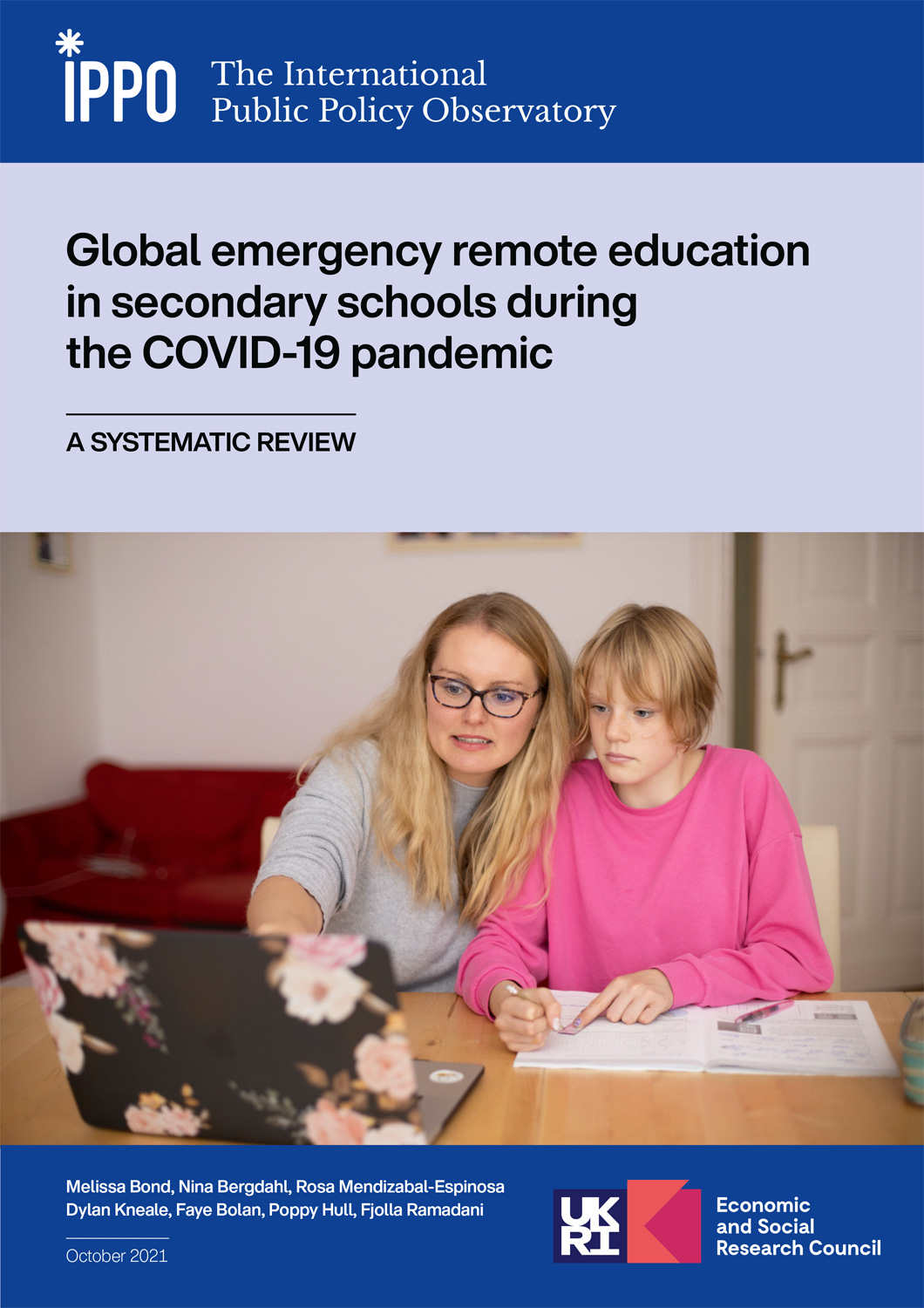
With more than 200,000 school children in England alone estimated to have been off school for COVID-related reasons at the end of September, and concerns over the number of teachers currently isolating, the question of how best to conduct remote emergency learning remains of critical importance in this new academic year.
The pandemic has sparked an extraordinary burst of innovation in online learning techniques, from facilitating peer collaboration in breakout rooms, to enabling virtual dance and music classes through the use of multiple digital devices. Note: see this IPPO blog by Glasgow-based biology teacher Paul Downie for more insights.
But what does global evidence tell us about the kinds of strategies that have proven most engaging and rewarding for secondary school students, teachers and parents? And what could this mean for secondary education beyond the pandemic? This is a pressing issue for teachers who are struggling to simultaneously teach students in face-to-face classrooms and to teach students who are learning remotely due to COVID.
To bring global insights on these issues, the International Public Policy Observatory (IPPO) has carried out an unprecedented systematic review of emergency remote learning strategies employed in secondary schools across 38 countries during the pandemic. This review pulls together the most robust evidence from primary research to answer questions including:
- How was technology used and was it successful?
- How were student and parent engagement affected?
- How was student assessment managed?
- What online and ‘blended’ learning approaches could continue to be used post-pandemic?
1. How was technology used and was it successful?
- Effective remote learning depended on students having access to the necessary resources, including computers, internet access and a quiet place to study, as well as the requisite digital skills. The move to online learning highlighted systemic issues of equity, regarding both access to and quality of digital resources.
- Teachers with adequate digital skills were able to adapt their teaching practice to the online setting, such as using multiple digital platforms to run music or dance classes. Others encouraged students to disseminate their work publicly via social media, raising student interest through authentic, real-world tasks.
- Despite such striking examples of teachers’ digital creativity, however, many other teachers reported struggling with the shift to emergency remote teaching.
- Successful peer collaboration online depended on teachers’ technological skills and innovativeness. However, there were reports of hesitancy to facilitate this, due in part to safeguarding issues and limited training.
- Resources such as online quizzes and videos were found to enable effective teaching and learning. They helped prevent boredom, enabled self-paced learning and instant feedback, and for teachers they provided greater insight into student understanding and reduced workload due to being reusable and automatically corrected.
- Not all students were comfortable being on camera and/or being recorded, and social etiquette online could be challenging.
2. How were student and parent engagement affected?
- Not having to physically attend school reduced social pressure and social anxiety for many students, who could then concentrate more effectively.
- Providing social time for students during lessons and prioritising wellbeing over learning helped lessen the impact of extended social isolation. Allowing students to collaborate with one another was particularly important for enhancing engagement.
- The transition to online learning has disproportionately impacted some groups. For example, girls’ education was more likely to be disrupted due to caring duties and other pressures in some contexts.
- Parents were able to see what their children were learning more clearly and felt more engaged, particularly through the use of social media (such as Facebook groups and group chats created specifically for individual classes) and school learning platforms.
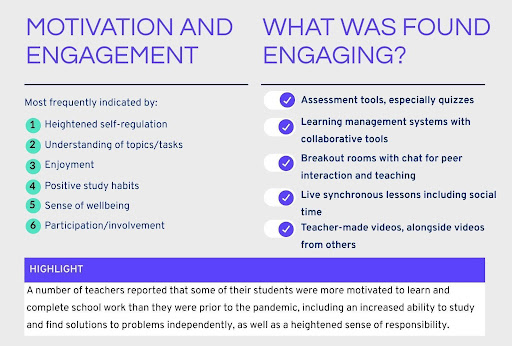
3. How was student assessment managed?
- When assessing online, ‘dynamic’ assessments (e.g. spoken) were found to integrate well with synchronous lessons, while digital media, such as photos and recordings, were found to effectively complement asynchronous student assignments.
- As well as using online quizzes to assess understanding, the introduction of more peer and self-assessment alongside teachers recording themselves speaking while marking work worked well.
- Cheating became more problematic as the pandemic progressed for some teachers.
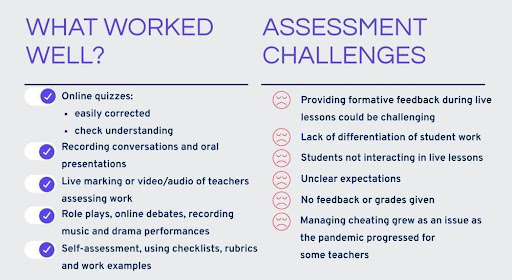
4. What online and ‘blended’ learning approaches could continue to be used post-pandemic?
The review’s authors are available to discuss what the future of secondary-age education could (and should) look like in light of the dramatic expansion of remote/online learning tools and techniques during the pandemic. Here, they offer some broad conclusions based on all the evidence they have assessed from around the world:
Priority recommendations:
- We expect the accelerated use of ‘asynchronous’ (non-live) learning techniques during COVID-19 to continue beyond the pandemic, including through the increased use of recorded lessons. However, our analysis suggests that for teachers making a rapid shift from classroom to emergency remote teaching, live ‘hybrid’ online lessons remain the most effective approach.
- Increased professional development for teachers on how to teach with digital technologies in blended, online and hybrid contexts, including online strategies for students with SEND, is vital. Their ongoing professional development should be updated in line with the latest technological advances.
Online tools and techniques:
- Online teaching materials developed during COVID-19 are a sustainable resource that can be reused and developed further in the future. This review refers to many local examples of tools and techniques that were developed by teachers during lockdown.
- Both educational videos (especially teacher-made) and online quizzes should be integrated within normal in-person schooling to consolidate understanding and ensure students have a sustainable workload.
- Changes to policy regarding teacher contact time may need to reflect the increased amount of time it takes to create rich digital resources.
Enhancing student engagement:
- Some students enjoyed the increased opportunities to study and problem-solve independently: for example, being set a week’s work on Monday and then scheduling their own timetable. One study found that chemistry students liked conducting experiments at home using everyday materials.
- ‘Scaffolding’ (i.e., not delivering all learning materials at once), varying the learning tasks and providing engaging, easy-to-understand instructions all help prevent students from feeling overwhelmed and confused when being taught outside the classroom.
- Peer collaboration is vitally important when students are learning remotely, as it helps to mitigate against social isolation and is critical for student engagement. Well-managed peer-to-peer interaction should be a key plank of future crisis response strategies.
- Technology choices should be governed by students’ ability to reliably access and use the tools in question – this will, of course, vary geographically, between schools, and even within a class.
And a point about parent engagement:
- It is critical that the improved communication between schools and parents seen during the pandemic continues and is actively built into any future remote learning strategies as a means of reducing barriers.
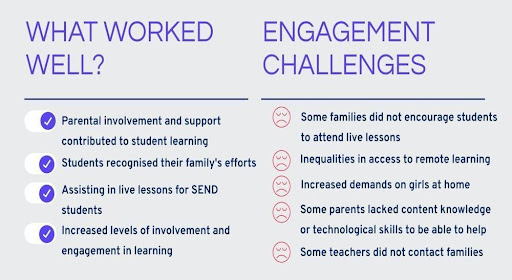
Additional notes about this review
This review was undertaken by the UCL EPPI Centre, a partner in the ESRC-funded International Public Policy Observatory (IPPO). It examines 81 studies across 38 countries during the pandemic. It does not cover issues relating to ethical concerns such as cyberbullying.
The evidence shows that switching to remote learning proved particularly problematic for students who did not have access to the necessary resources, including computers, internet access and a quiet place to study at home. This topic is covered in more detail in this IPPO Rapid Evidence Review, published on 9 September 2021.
Although this review aimed to cover how well technology worked for students with special educational needs or disabilities (SEND), disappointingly there proved to be scant research evidence on this issue within the selected studies.
The EPPI Centre is a specialist centre in the UCL Social Research Institute which develops methods (i) for the systematic reviewing and synthesis of research evidence; and (ii) for the study of the use of this research.
Review authors
- Lead author: Dr Melissa Bond, EPPI-Centre, UCL Social Research Institute
- Dr Nina Bergdahl, Dept. of Computer and Systems Sciences, DSV, Stockholm University, Sweden; Dept. of Upper-Secondary and Adult Education, Malmoe, Sweden
- Dr Rosa Mendizabal-Espinosa, EPPI-Centre, UCL Social Research Institute
- Dr Dylan Kneale, EPPI-Centre, UCL Social Research Institute
- Faye Bolan, EPPI-Centre, UCL Social Research Institute
- Poppy Hull, EPPI-Centre, UCL Social Research Institute
- Fjolla Ramadani, EPPI-Centre, UCL Social Research Institute
For more information about this IPPO systematic review or to speak to one of its authors, please email IPPO at ippo@ucl.ac.uk
